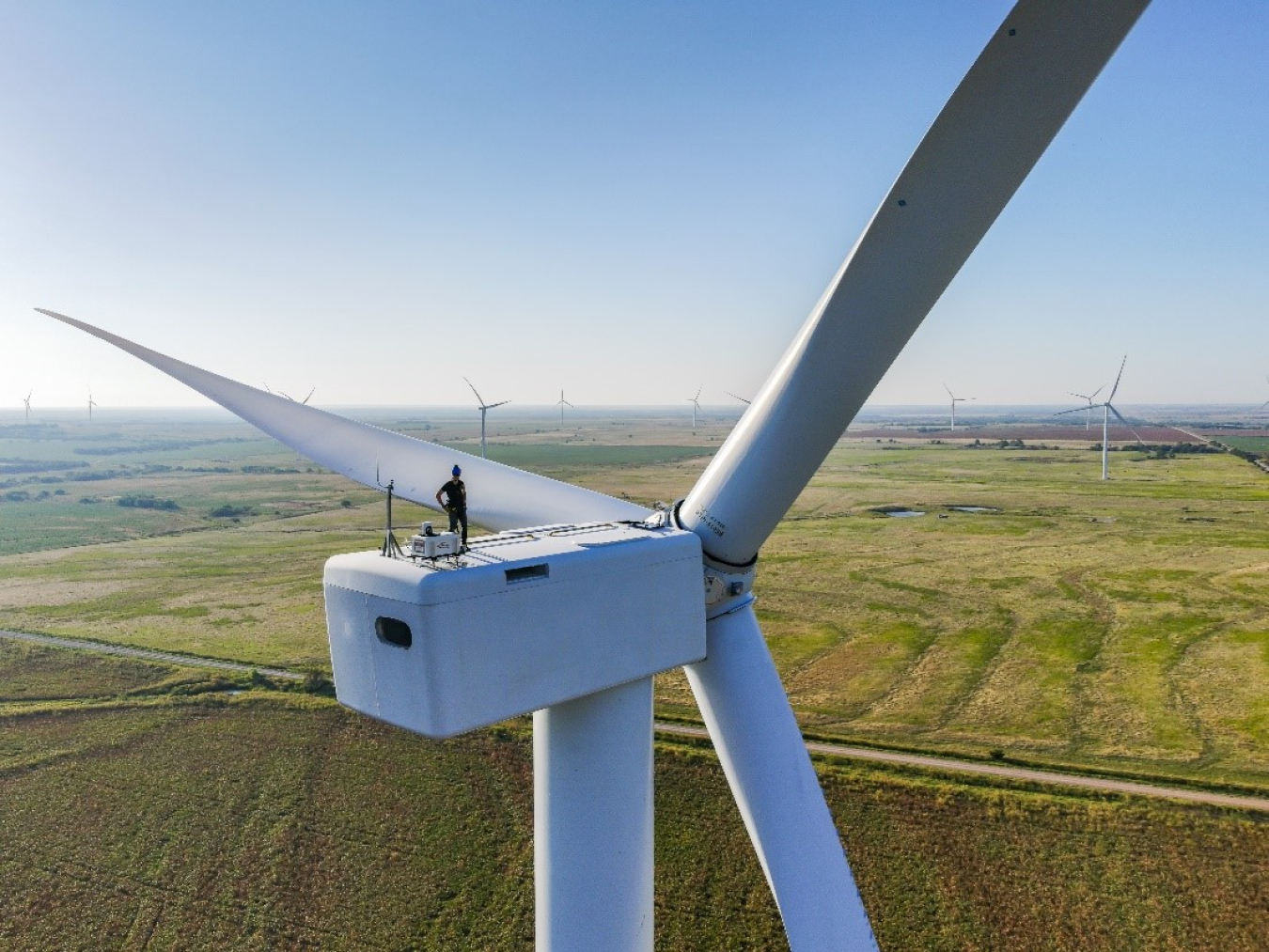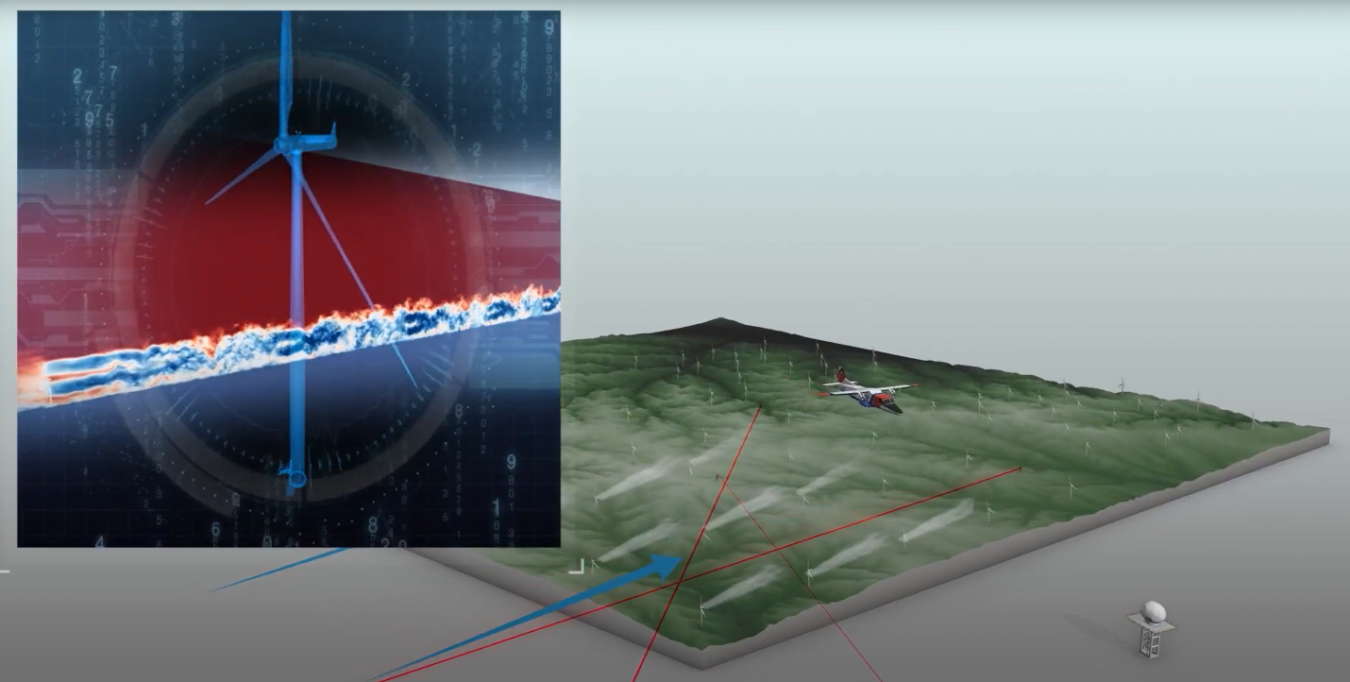The American WAKE experimeNt (AWAKEN) is compiling the world’s largest and most comprehensive dataset on wind energy atmospheric phenomena, detailing how wind and surrounding air particles interact with wind turbines and wind farms.
Wind Energy Technologies Office
October 10, 2024
Like musicians in an orchestra, the components of a wind system deliver the best performance when they work in concert. Finely tuned and synchronized instruments are the key to striking the right pitch―and propelling wind energy forward.
As momentum for clean energy continues to build across the United States, U.S. Department of Energy DOE-funded efforts are underway to dramatically increase the maximum amount of electricity wind farms can produce when operating at full capacity. Two recent projects funded by DOE’s Wind Energy Technologies Office are helping industry expand wind power capacity.
The American WAKE experimeNt (AWAKEN) is compiling the world’s largest and most comprehensive dataset on wind energy atmospheric phenomena, detailing how wind and surrounding air particles interact with wind turbines and wind farms. This dataset could be used to improve the flow of wind through the average wind power plant and boost potential electricity output by 5%―enough to power approximately 4,000 homes each year.
Turbine placement—either within a single wind farm or across several—can impact wind speed and the amount of power downwind turbines can produce. This is known as the “wake effect,” or the change in the flow of wind after it interacts with a wind turbine or plant.
The project leverages the expertise and resources of DOE’s National Renewable Energy Laboratory (NREL) and its partners, including Lawrence Livermore National Laboratory, Pacific Northwest National Laboratory, and Sandia National Laboratories, as well as universities, research institutions, and industry.
New Equipment AWAKENs Knowledge About Wind Flow
Wakes are among the least-understood physical phenomena in wind plants. Until recently, models and simulations could estimate how winds might move through multiple turbines, but insufficient observational data existed to back up projections. This means researchers, developers, and operators still needed to estimate how much energy loss occurs in wind systems downwind from other plants but could not accurately quantify wake effects.
New observations made by the AWAKEN team, which confirmed the existence and measured the extent of wind farm wakes, are likely to trigger new innovations in wind farm siting and operation.

As a result of the team’s findings, “designers and developers may decide to spread wind turbines over more acres or position them differently to regenerate winds between plants,” said NREL Senior Engineer and AWAKEN Project Lead Patrick Moriarty. “In some cases, wind plants may intentionally capture less wind and allow some of it to go through to neighboring downwind wind turbines or plants.”
Researchers already knew wakes reduced wind speeds and power output while increasing costs and turbulence for downstream turbines, but they had not quantified the cumulative impact of these effects. Recently, the AWAKEN team gathered more precise observational data using an array of sensors and created a 3D picture of how wind currents move around the turbines. This made it possible for the team to study the effects of large-scale wakes across distances of 20 miles and encompassing multiple wind plants, then conduct unique simulations of interactions based on observations.
Not surprisingly, wind turbines reduce the wind speeds not just within the immediate wake but also above the wind plant, making less energy available downwind. This means there may be some mutual benefit from cooperation between neighboring wind farm operators if they are waking each other at different times.
So far, AWAKEN has amassed more than 77 terabytes of data stored in 12 million files on DOE’s Wind Data Hub. Researchers worldwide are already making use of the publicly available data with more than 15 million downloads.
Moriarty said, “It may take a decade or more to make use of all the intelligence gathered through AWAKEN. Analyzing this vast treasure trove of data is a daunting task, but understanding these metrics will be crucial in improving modeling and simulation tools, as well as actual wind plant controls.”
Research Helps Map Priorities for Next-Generation Instruments
Additional research on instrumentation originally used internally by teams on the Wind Energy Technologies Office’s Atmosphere to Electrons initiatives, such as AWAKEN, and Rotor Aerodynamics Aeroelastics and Wake, the recently released Wind Energy Instrumentation Development Roadmap assesses current state-of-the-art wind instrumentation, pinpoints unmet measurement needs, outlines development priorities for the next five years, and recommends a path forward to address gaps.
“We can model really fine details of the movement of wind through wind farms, but we have trouble measuring that same level of detail. This makes attaining necessary measurements nearly impossible,” said Roadmap lead author and Sandia Instrumentation Engineer Thomas Herges. “Identifying and creating the most-needed high-fidelity instruments will finally allow us to accurately validate complex models. In turn, this will speed the advancement of wind energy innovation.”
New measurement systems and sensors that can be integrated into turbine operation will reduce uncertainty in model simulation, leading to improvements in wind system design. Eventually, these improved technologies and monitoring devices will help produce more dependable, durable, affordable, and scalable commercial turbines.
Roadmap development was led by members of the AWAKEN team at Sandia, in partnership with NREL, PNNL, and the University of Wyoming. Vital supporting input was provided by Lawrence Livermore National Laboratory and the National Oceanic and Atmospheric Administration as well as members of the North American Wind Energy Academy and the International Energy Agency. The team collaborated with international experts in instrumentation, wind energy, and atmospheric science to identify instrumentation needed to capture information on the atmosphere, environment, turbine response, and wind plant control.
The Roadmap ranks the potential impact of new instruments and assesses the feasibility of deployment in shorter term (one- to three-year) and longer term (four- to ten-year) time frames. Feasibility scores reflect instruments’ abilities to capture needed measurements, development cost and time, development uncertainty, and deployment logistics.
Herges said, “In addition to pinpointing top instrumentation needs, the Roadmap team counts the assessment framework itself as an important outcome. The effort reveals the importance of considering instrumentation limits, as well as knowledge of the scale, environment, and turbine system when planning an experiment.”
Maintaining the Tempo of Wind Developments
Researchers expect the methods, tools, and data originally developed for AWAKEN and the related Instrumentation Roadmap to be updated regularly and evolve over time.
The AWAKEN team hopes to perform a similar massive field campaign to map out wake effects in offshore wind plants—especially floating offshore wind plants. There are also plans to improve data collection tools and eventually make an even higher-resolution map of how winds move through wind plants. In the future, the Roadmap team will expand the scope by adding instrumentation experts who specialize in the study of the atmosphere, water, soil, the grid, and blade-turbine and platform-mooring structures.
“While the instrumentation might not be identical for all projects, the approach should be useful for many other experiments,” said Moriarty. “A number of the high-priority instruments were developed for use in Rotor Aerodynamics Aeroelastics and Wake and AWAKEN field tests. We learned a lot about how they perform and where they might need improvements.”
Read the AWAKEN fact sheet for an overview of the initiative, visit the project website for more detailed information, and find data on the DOE Wind Data Hub. View and download the full Wind Energy Instrumentation Development Roadmap.

